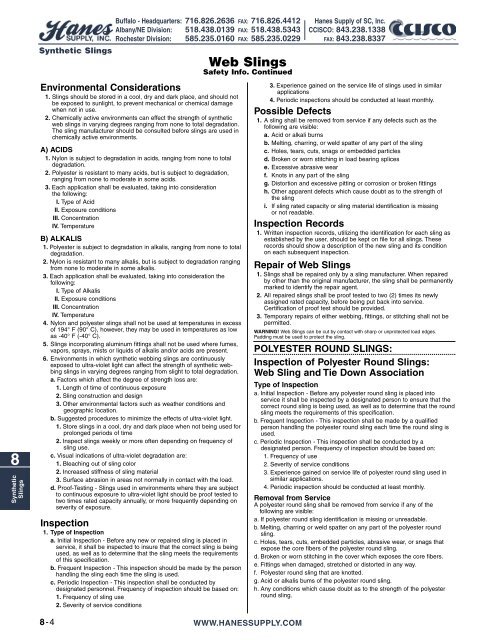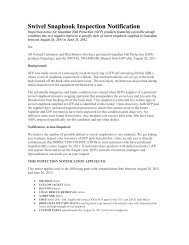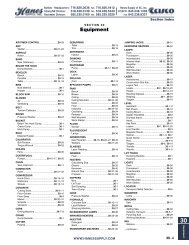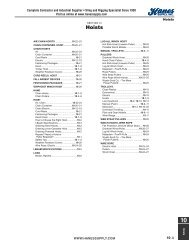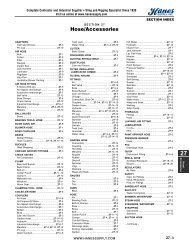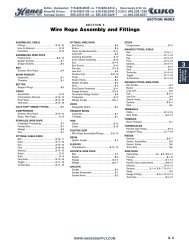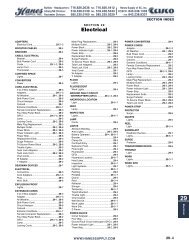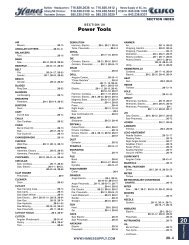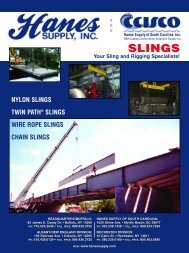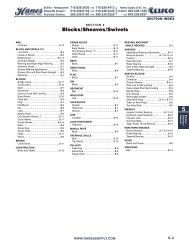Synthetic Slings - Hanes Supply, Inc
Synthetic Slings - Hanes Supply, Inc
Synthetic Slings - Hanes Supply, Inc
Create successful ePaper yourself
Turn your PDF publications into a flip-book with our unique Google optimized e-Paper software.
<strong>Synthetic</strong> <strong>Slings</strong><br />
Buffalo - Headquarters: 716.826.2636 FAX: 716.826.4412<br />
Albany/NE Division: 518.438.0139 FAX: 518.438.5343<br />
Rochester Division: 585.235.0160 FAX: 585.235.0229<br />
Web <strong>Slings</strong><br />
Safety Info. Continued<br />
<strong>Hanes</strong> <strong>Supply</strong> of SC, <strong>Inc</strong>.<br />
CCISCO: 843.238.1338<br />
FAX: 843.238.8337<br />
8<br />
<strong>Synthetic</strong><br />
<strong>Slings</strong><br />
Environmental Considerations<br />
1. <strong>Slings</strong> should be stored in a cool, dry and dark place, and should not<br />
be exposed to sunlight, to prevent mechanical or chemical damage<br />
when not in use.<br />
2. Chemically active environments can effect the strength of synthetic<br />
web slings in varying degrees ranging from none to total degradation.<br />
The sling manufacturer should be consulted before slings are used in<br />
chemically active environments.<br />
A) ACIDS<br />
1. Nylon is subject to degradation in acids, ranging from none to total<br />
degradation.<br />
2. Polyester is resistant to many acids, but is subject to degradation,<br />
ranging from none to moderate in some acids.<br />
3. Each application shall be evaluated, taking into consideration<br />
the following:<br />
I. Type of Acid<br />
II. Exposure conditions<br />
III. Concentration<br />
IV. Temperature<br />
B) ALKALIS<br />
1. Polyester is subject to degradation in alkalis, ranging from none to total<br />
degradation.<br />
2. Nylon is resistant to many alkalis, but is subject to degradation ranging<br />
from none to moderate in some alkalis.<br />
3. Each application shall be evaluated, taking into consideration the<br />
following:<br />
I. Type of Alkalis<br />
II. Exposure conditions<br />
III. Concentration<br />
IV. Temperature<br />
4. Nylon and polyester slings shall not be used at temperatures in excess<br />
of 194° F (90° C), however, they may be used in temperatures as low<br />
as -40° F (-40° C).<br />
5. <strong>Slings</strong> incorporating aluminum fittings shall not be used where fumes,<br />
vapors, sprays, mists or liquids of alkalis and/or acids are present.<br />
6. Environments in which synthetic webbing slings are continuously<br />
exposed to ultra-violet light can affect the strength of synthetic webbing<br />
slings in varying degrees ranging from slight to total degradation.<br />
a. Factors which affect the degree of strength loss are:<br />
1. Length of time of continuous exposure<br />
2. Sling construction and design<br />
3. Other environmental factors such as weather conditions and<br />
geographic location.<br />
b. Suggested procedures to minimize the effects of ultra-violet light.<br />
1. Store slings in a cool, dry and dark place when not being used for<br />
prolonged periods of time<br />
2. Inspect slings weekly or more often depending on frequency of<br />
sling use.<br />
c. Visual indications of ultra-violet degradation are:<br />
1. Bleaching out of sling color<br />
2. <strong>Inc</strong>reased stiffness of sling material<br />
3. Surface abrasion in areas not normally in contact with the load.<br />
d. Proof-Testing - <strong>Slings</strong> used in environments where they are subject<br />
to continuous exposure to ultra-violet light should be proof tested to<br />
two times rated capacity annually, or more frequently depending on<br />
severity of exposure.<br />
Inspection<br />
1. Type of Inspection<br />
a. Initial Inspection - Before any new or repaired sling is placed in<br />
service, it shall be inspected to insure that the correct sling is being<br />
used, as well as to determine that the sling meets the requirements<br />
of this specification.<br />
b. Frequent Inspection - This inspection should be made by the person<br />
handling the sling each time the sling is used.<br />
c. Periodic Inspection - This inspection shall be conducted by<br />
designated personnel. Frequency of inspection should be based on:<br />
1. Frequency of sling use<br />
2. Severity of service conditions<br />
3. Experience gained on the service life of slings used in similar<br />
applications<br />
4. Periodic inspections should be conducted at least monthly.<br />
Possible Defects<br />
1. A sling shall be removed from service if any defects such as the<br />
following are visible:<br />
a. Acid or alkali burns<br />
b. Melting, charring, or weld spatter of any part of the sling<br />
c. Holes, tears, cuts, snags or embedded particles<br />
d. Broken or worn stitching in load bearing splices<br />
e. Excessive abrasive wear<br />
f. Knots in any part of the sling<br />
g. Distortion and excessive pitting or corrosion or broken fittings<br />
h. Other apparent defects which cause doubt as to the strength of<br />
the sling<br />
i. If sling rated capacity or sling material identification is missing<br />
or not readable.<br />
Inspection Records<br />
1. Written inspection records, utilizing the identification for each sling as<br />
established by the user, should be kept on file for all slings. These<br />
records should show a description of the new sling and its condition<br />
on each subsequent inspection.<br />
Repair of Web <strong>Slings</strong><br />
1. <strong>Slings</strong> shall be repaired only by a sling manufacturer. When repaired<br />
by other than the original manufacturer, the sling shall be permanently<br />
marked to identify the repair agent.<br />
2. All repaired slings shall be proof tested to two (2) times its newly<br />
assigned rated capacity, before being put back into service.<br />
Certification of proof test should be provided.<br />
3. Temporary repairs of either webbing, fittings, or stitching shall not be<br />
permitted.<br />
WARNING! Web <strong>Slings</strong> can be cut by contact with sharp or unprotected load edges.<br />
Padding must be used to protect the sling.<br />
POLYESTER ROUND SLINGS:<br />
Inspection of Polyester Round <strong>Slings</strong>:<br />
Web Sling and Tie Down Association<br />
Type of Inspection<br />
a. Initial Inspection - Before any polyester round sling is placed into<br />
service it shall be inspected by a designated person to ensure that the<br />
correct round sling is being used, as well as to determine that the round<br />
sling meets the requirements of this specification.<br />
b. Frequent Inspection - This inspection shall be made by a qualified<br />
person handling the polyester round sling each time the round sling is<br />
used.<br />
c. Periodic Inspection - This inspection shall be conducted by a<br />
designated person. Frequency of inspection should be based on:<br />
1. Frequency of use<br />
2. Severity of service conditions<br />
3. Experience gained on service life of polyester round sling used in<br />
similar applications.<br />
4. Periodic inspection should be conducted at least monthly.<br />
Removal from Service<br />
A polyester round sling shall be removed from service if any of the<br />
following are visible:<br />
a. If polyester round sling identification is missing or unreadable.<br />
b. Melting, charring or weld spatter on any part of the polyester round<br />
sling.<br />
c. Holes, tears, cuts, embedded particles, abrasive wear, or snags that<br />
expose the core fibers of the polyester round sling.<br />
d. Broken or worn stitching in the cover which exposes the core fibers.<br />
e. Fittings when damaged, stretched or distorted in any way.<br />
f. Polyester round sling that are knotted.<br />
g. Acid or alkalis bums of the polyester round sling.<br />
h. Any conditions which cause doubt as to the strength of the polyester<br />
round sling.<br />
8-4<br />
WWW.HANESSUPPLY.COM


